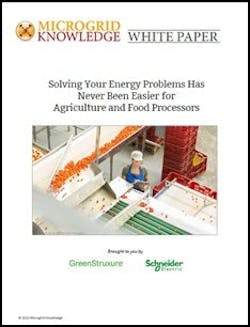Farmers, food processors, and operators in the agriculture space are increasingly challenged by energy problems like higher energy costs, electric reliability issues and the need to cut greenhouse gas emissions. From small family farms to large commercial operation, the agriculture industry is looking for ways to turn those challenges into opportunities. A microgrid could do just that.
Microgrids provide four key benefits to the agriculture industry, food producers and others in the food supply chain to solve their energy problems. First, they offer resilience through increase electric reliability. Second, they improve sustainability by reducing the operation’s greenhouse gas emissions. Third, they provide predictable energy costs. Finally, microgrids allow the organization to grow their business through the electrification of formerly manual operations. There are three primary business models that those in the space can employ when working with a microgrid developer: ownership, leasing or energy-as-a-service.
In this white paper, learn what microgrids are, how they work, how they’re funded and how they can benefit food processors and the wider agriculture industry.
